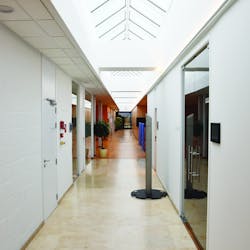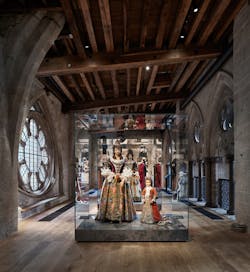With all of the technological advances that have defined the lighting industry in recent years, it seems reasonable to assume its growth would skyrocket at full speed — especially in the commercial connected lighting market, where the evolution from intelligently controlling lighting to supporting whole-building automation shows such incredible promise. However, like many advances in technology, there may be some initial barriers to overcome for an industry to hit its potential and open up widespread adoption. Some of these challenges are less tangible than others. For instance, educating customers around the full value and promise of connected lighting is an ongoing task that may never go away. Proper training of building staff to adequately manage and maintain connected lighting systems is also a continuing concern. Perhaps the most critical challenge to overcome is achieving open interoperability through wireless technology standards. Without truly open and interoperable systems, proprietary and closed solutions will limit expansion and keep deployment cost high, and mass adoption simply isn’t possible. The outlook for commercial connected lighting is strong, as long as the industry can rally to break through these barriers to achieve accelerated growth.
The state of commercial connected lighting
Within the commercial sector, lighting is a high-impact pathway to deliver what customers demand — digital solutions, data-driven insights, and more customization and control to improve their occupant experience and energy efficiency. Lighting control technologies have significantly advanced from the days of manual on/off switches. From multi-feature sensors and luminaires embedded with controls to systems that interact with other buildings systems, such as heating, ventilation, and air conditioning (HVAC), security, and fire safety, lighting systems have become intelligent and data driven. Today’s commercial connected lighting technologies can connect billions of lighting devices, providing a data platform that gleans actionable insights and helps building owners and managers cut their costs and energy consumption. Intelligent sensors, luminaires embedded with sensors, relays, and switches are the key components that make these advancements possible.
With the growth of LED technology and the need for energy reduction in buildings, the commercial connected lighting industry is poised for accelerated adoption in the next decade. Its global revenue is estimated to grow from roughly $4.4B (billion) in 2020 to $19.1B in 2029 at a compound annual growth rate of 17.9%, according to Guidehouse Insights.
There are three key drivers accelerating growth in the connected lighting market.
Proliferation of LEDs. The rapid growth of LED technology has paved the way to increased adoption of connected lighting systems. With a foundation of LEDs, commercial building managers are more easily positioned to switch to connected lighting systems.
Energy savings. It’s no secret that upgrading from traditional lights to energy-efficient LEDs is one way to conserve energy — but that is only the start. The industry has seen the opportunity for tremendous energy savings from lighting control strategies such as occupancy sensors, daylighting, and demand management. From networked on/off and dimming controls to the use of sensors to detect occupancy, these strategies help building managers conserve energy and associated costs.
Growth of the Internet of Things (IoT) and connected devices. Advances in performance monitoring, diagnostics, and predictive maintenance through data have also impacted the growth of the connected lighting market. As building managers are demanding greater insights into their commercial spaces, forgoing this available data today is a waste. Connected lighting systems also provide the infrastructure for data and integration with other building automation systems.
Connected lighting market barriers
While the commercial connected lighting market is gaining traction, there are still a few barriers inhibiting the speed and scale of its growth. Three major challenges come into play when educating and marketing connected lighting solutions. First, there is the lack of clarity around the return on investment (ROI) of connected lighting systems beyond that of LED replacement. Second is the availability of properly trained staff, inhibiting building and facilities managers from reaping the expected benefits of their investment. Finally, closed systems, the antithesis of open standardization, are hindering interoperability, preventing multi-source selection and impeding widespread adoption.
Let’s take a closer look at each of these barriers and how the industry can overcome them together to reach its full potential.
Clarity of the ROI beyond LED replacement. Implementing connected lighting systems does come at a premium, but justifying that premium requires clear communication of the full value proposition and ROI beyond simple LED replacement.
While simple LED retrofits are understood to reduce energy consumption, a connected lighting system can create distinct value in serving as a building’s central nervous system for various services. The investment in connected lighting infrastructure becomes an investment in a building-wide connectivity grid with a long list of benefits. The data flowing through this infrastructure enables building managers to integrate, automate, and extend the life of core building systems, lower their operating costs, increase performance, decrease downtime, and even support advanced services such as asset tracking and wayfinding. According to Szymon Slupik, CTO and founder of Silvair, “The value of additional services enabled by smart lighting is seven to ten times more valuable than the lighting controls and energy savings themselves.” In short, the benefits of connected lighting go far beyond illumination.
More consistent terminology can also help clarify communication around ROI. Connected lighting, networked lighting controls, advanced lighting controls, intelligent lighting, and smart lighting are all synonymous with certain brands. However, it’s not clear to customers whether there is any meaningful difference between these labels in terms of features or functionalities.
To grow connected lighting adoption, lighting associations, alliances, and solutions providers should focus on identifying broader needs and clearly communicating the ROI and full value proposition of a connected lighting system to the right people in the decision-making process. Education must go outside of the lighting ecosystem — to business leaders, property and facilities managers, and building owners. Within the ecosystem, key players including electrical engineers and lighting designers must also be able to articulate this expanded value of connected lighting beyond LED replacement. If key players work together to communicate clearly and consistently, the industry as a whole benefits.
Advancing staff training. Let’s say a building manager does embrace the full value proposition of a connected lighting system and decides to move forward with implementation. In a best-case scenario, the reality of that implementation should meet or even exceed expectations. That brings us to our next market barrier. Some customers are experiencing gaps between the performance that’s modeled during the design phase and the actual documented performance during operations. These gaps can often be attributed to a human element in training. Those on staff may not have the necessary experience to ensure these systems perform to their utmost capabilities and achieve anticipated ROI.
To overcome the disconnect, professionals need a plan, and they need to be trained on how to manage and maintain these new advanced systems. The solutions providers play a critical role in selling the value of connected lighting by educating customers on the need for this training. Yes, it may be seen as an additional cost and time, but in order for customers to reap the full benefits of connected lighting, workforce development is likely needed.
Moving from closed systems toward standardization. Standards are critical for the mass adoption of any technological innovation. When standards are enforced and adopted, devices from all different brands can work together, creating an interoperable ecosystem that is easier to use and maintain. In commercial connected lighting, many of the current wireless communication systems are proprietary, causing a lack of openness across vendors and an inability to source products for best performance and cost for the application. This inhibits the growth of connected networks and locks customers into a single vendor approach.
The lighting industry needs to converge toward a common set of standards and a commitment to an open and interoperable environment that will lower the risk of incompatible solutions and unexpected operating costs. The openness and interoperability of connected lighting products from different lighting vendors will provide more options, flexibility, and wider adoption for the specifier to select compatible solutions knowing that they will work and save time.
The Bluetooth Special Interest Group (SIG) helped the lighting industry take a significant step toward standardization in 2017 with its release of Bluetooth mesh, which is optimized for creating large-scale device networks. Since then, the Bluetooth SIG and the DALI Alliance have also collaborated to specify a standardized interface that will enable D4i certified luminaires and DALI-2 devices to be deployed within qualified Bluetooth mesh lighting control networks. In other words, data can flow freely between sensor-rich luminaires and lighting controls, and even more important, to other building management systems. In order to drive widespread adoption, the connected lighting industry must continue to build these bridges of open standardization.
Wireless technology opportunity
As you may have guessed, wireless technologies play a key role in addressing these adoption barriers. The promise of connected lighting has been clear for some time, but the lack of a single dominant control technology has hindered the adoption of these systems. This is where wireless technologies such as Bluetooth come in, paving the way with greater flexibility, easing installation and use for retrofitting, and offering solutions with flexibility and scalability, at a lower cost of installation:
- Greater flexibility. As building owners look for ways to reduce costs and optimize building efficiency, wireless technologies provide a better solution for retrofit projects. The use of wireless technology enables the installation of new sensors where needed and allows for the existing lighting infrastructure to remain in place. In the coming years, wireless technology retrofits are expected to lead the commercial connected lighting market, as opposed to the increased time and costs of construction from scratch (according to Guidehouse Insights market report, linked above).
- Ease of installation and use. Building managers need an infrastructure that is easy to integrate into environments and is intuitive to use. With wireless technologies, sensors are easily installed and adapted for building performance, without concern over wiring configuration. In terms of user experience, wireless technologies also allow for efficient communication and data transfer between the lighting systems and users, enabling greater personal control and ease of use.
- Lower costs. Traditional lighting control systems result in high costs due to labor, equipment, and the installation of control wiring. As reduced costs are associated with these factors, wireless technology enables a more affordable and scalable solution for commercial buildings and lower total cost of ownership.
The fact is, the growth of the commercial connected lighting industry is reliant on wireless technology for its ability to reliably connect hundreds, and even thousands of lighting devices in complex commercial settings. Industry leaders like Osram, Signify, and others have developed lighting control systems based on Bluetooth mesh that are free of wiring, use less power, and offer more flexibility in deployment. Deployed in settings across enterprise, retail, and manufacturing, wireless lighting systems also enable control strategies that digitize and optimize a building with services like space utilization, occupancy management, and indoor positioning.
The path to accelerated adoption
With technology milestones and global revenue expected to quadruple in the next decade, the future of the commercial connected lighting market is bright (Guidehouse Insights, linked above). Energy savings, LED technology, and a steady advance of the IoT and connected devices will continue to drive adoption. At the same time, wireless technologies are expected to spur even greater market growth and address many of the remaining adoption barriers. There will still be challenges to overcome, but the ubiquity of lighting in commercial settings will cement its role in the future of smart buildings — it’s simply a matter of reaching its fullest potential.
Get to know our expert
HENRY WONG is responsible for market development at Bluetooth SIG. In his role, he works with Bluetooth member companies and other influencers to identify opportunities in strategic markets and create development plans and programs to realize the opportunity. Prior to Bluetooth SIG, Wong held various leadership positions with Wacom, Cypress Semiconductor, DTS, Integrated Device Technology, Infineon Technologies, Philips, Intel, and others across three continents. In addition to his progressive experience from IC design to product marketing, business development, product management, and product development, Wong is an inventor with multiple patents. He holds a B.S. in computer and systems engineering from Rensselaer Polytechnic Institute.







